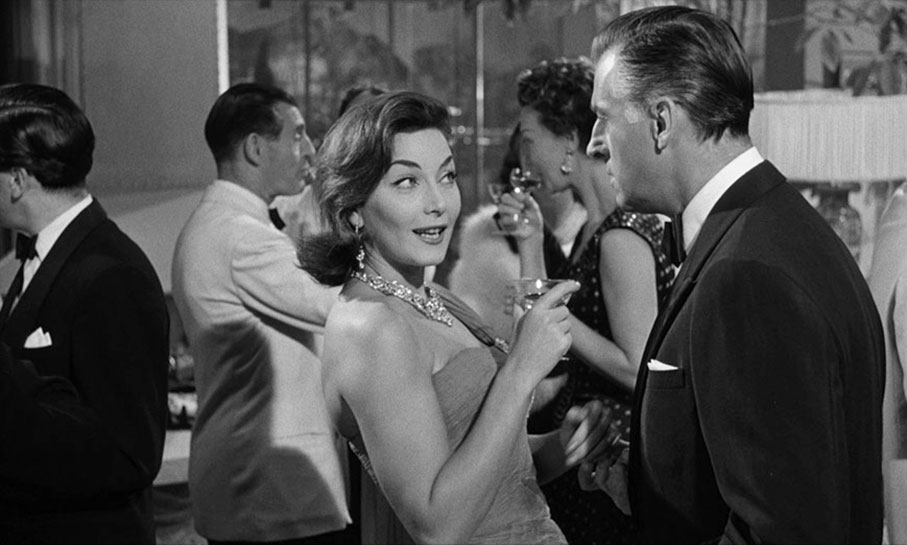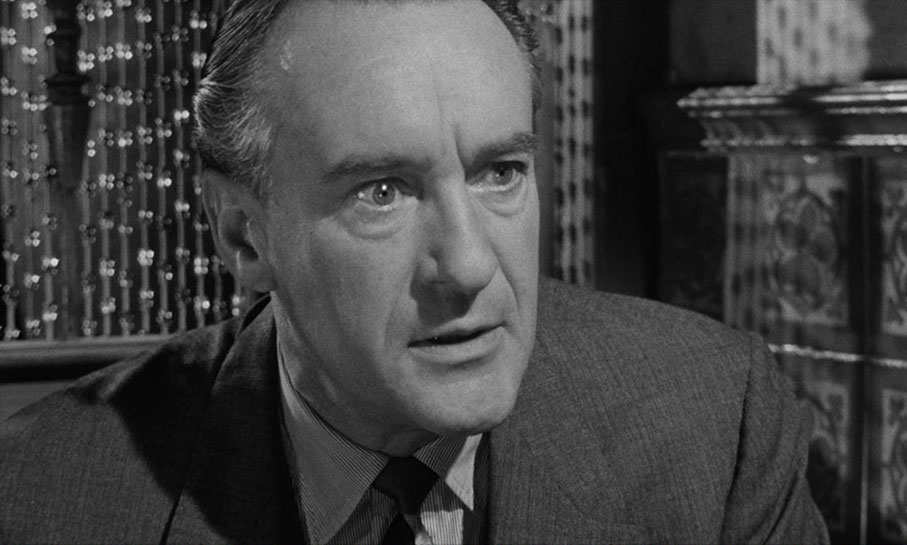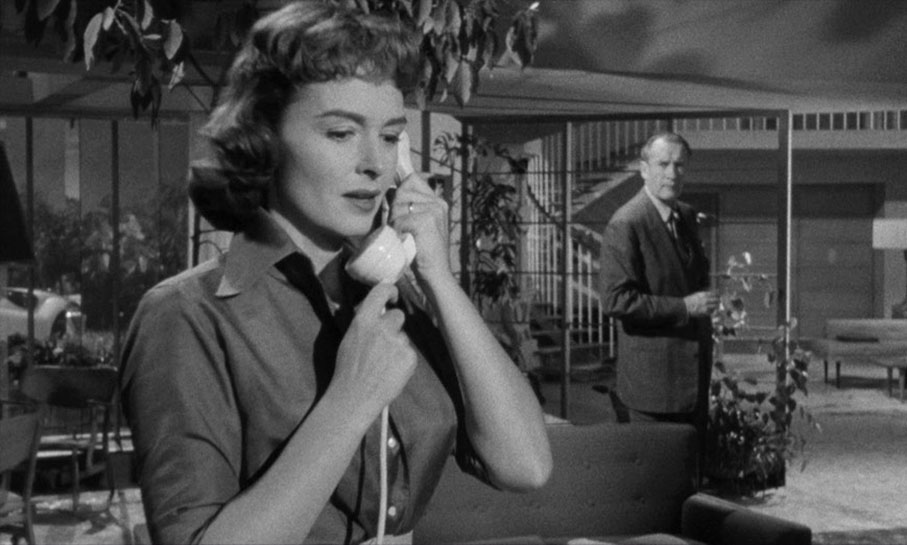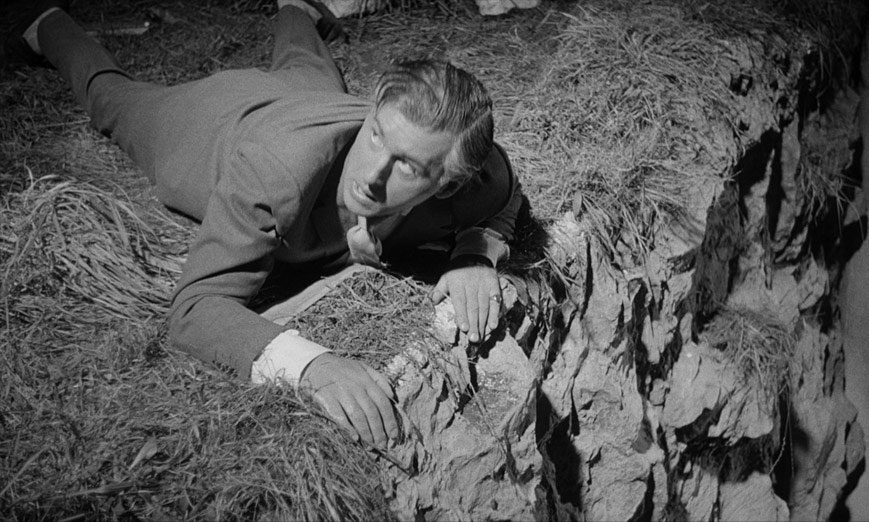| |
"I thought there was a lot of art in his films. At some point, I started looking to see what there was written about him. Only a few paragraphs here and there, and they were entirely about his temper. The whole entry on Wikipedia was about his bad temper. After his death it was fuller, but I knew he wouldn't want to be known just for The Towering Inferno." |
| |
John Guillermin's widow, Mary* |
I'll state up front that The Whole Truth is not a whodunnit per se. There is some circumstantial doubt about the leading man's innocence but the film quickly shows its hand and the meat of the plot is how does an expertly framed man figure out how to save himself. A member of the gendarme in the south of France has a smoke on patrol in the narrow, serpentine streets. We hear the smashing of a window and see a desperate man on the run from the closing lawmen. He holes up in alcoves and as he evades the glare of torchlight, he stares at a clocktower… And, dear tasteful readers of this site, here we have a first class example of what swiftly became a cliché in Hollywood, the wobble back in time effect where the image shimmers and we dissolve to presumably the beginning of the events that forced the desperate man to crash through a window in the first place. As a nice touch, the clock hands actually start moving backward just in case we didn't get it.

Max Poulton is a suave, tall, handsome, impeccably tailored film producer driving his status-conferring convertible along the French coast. He arrives at a studio to witness a scene being shot with his Italian star, Gina Bertini in full diva mode. Gina wants Max to reignite their previous affair and Max is having none of it wanting to maintain his relationship with his wife Carol. He drops Gina off and returns to his evening party after Gina threatens to reveal their affair. During the party, a suave Brit called Carliss of Scotland Yard arrives to break the news that Gina Bertini has been murdered… Max is shocked. He surreptitiously slips out to collect any evidence of him being at Gina's flat. Returning to the party, Max is twice as shocked when a very familiar face turns up drunk and says "Surprised to see me, darling?" Gina is very much alive. What the deuce is going on here? I'll say no more. The rest plays out very entertainingly as Max is snagged by the sticky web strands of a malevolent spider's plan, culminating in a desperate bid to escape from the police via a smashed window…
Again, what a delight coming in cold to a film I'd not heard of from a director whose work I've admired over decades. This little gem has a great cast and a few surprising supporting players, inventive direction and one might say innovative editing in terms of its era, its pace and transitional ideas (most of the latter, to be fair, probably came from the director). You can't do transitional image to similar image cuts unless the images have been planned and shot beforehand. But it sometimes takes the attention of a skilled editor to make that link if it wasn't always meant to be cut that way in the director's mind. The first time this technique is employed nine minutes in, is to transition between the spurned diva, to prop men uncovering a statue used for the next scene to be shot. Gina is frustrated and starts to undo the narrow belt of her silk dressing gown. As we tilt down, the gown drops and we cut to a sheet dropping to the ground and tilt up to see the statue it was covering. In 1958 editors and directors were not usually doing things like that. It just adds piquancy to the style of the presentation.

This was award winning editor Gerry Hambling's second film as a picture editor. He may not be a household name but in editing circles he was widely celebrated. His relationship with director Alan Parker showcased his best work, the airport arrest of Billy Hayes in Midnight Express, is one of his more showier scenes. The French dub of that scene is on YouTube. The stand out editorial device in The Whole Truth is the swish pan or swish tilt cut which makes the edit invisible. They increase in frequency as the action heats up and are very effective at turning the screws. It was decided to blow up a few shots for narrative clarity and this practice, while not overdone, pulls you up a little due to the evident increased grain of the resize.
To anyone with any recognition of standard film trickery, it is all too obvious that anything actually shot in the south of France features stand-ins or doubles of the cast and not too convincing doubles at that. The actors are shot against a back projected French background when in a car while actually being filmed in Walton Studios in Surrey not too far from Shepperton Studios. So while the film feels Hollywood with the Columbia logo its first image, it's British made through and through. One of the finest directors of his generation produced the film. It's Jack Clayton, who directed The Innocents, one of the very best ghost movies in my book.
Giving the film its US gloss are the actors. Brit Stewart Granger as Max is as Hollywood as it gets as too is Donna Reed playing his wife Carol. Both are effortless performers with Stewart and Reed playing a very credible power couple. Reed, with her wholesome girl-next-door demeanour and soft beauty was presumably cast to be the Italian diva's precise opposite. As Gina, Gianna Maria Canale is all angles, sharp eyes and a feline sex appeal that arrives in a room before she does. It was hoped this role might allow her to break through internationally but she plied her trade mostly in her native Italy. She is about as convincing as a diva as anyone could be and given the camera hog she's acting with, it doesn't surprise me that she bites his lip mid-kiss. Adding his charming menace, or indeed menacing charm, to the proceedings is George Sanders as Carliss. He's an actor I just could not imagine as a young man so ingrained in my film past as the older cynic. He was hugely memorable as Addison DeWitt in All About Eve, describing the then relatively unknown Marilyn Monroe's small part of Miss Casswell as "…an actress, a graduate of the Copacabana School of Dramatic Art." Nobody could deliver a put down like George Sanders and what a perfect fit as the voice of the tiger Shere Khan in the original Disney animated Jungle Book. Two other notables on the supporting cast are Peter Dyneley as the film director Willy and an unnamed small part for André Maranne. The latter popped up for years in any British productions needing a Frenchman. For my part, I recognise him as Sgt. Chevalier from the Pink Panther series, Fawlty Towers and Yes, Minister. The former, Peter Dyneley has very few lines but I have gone back and listened to them over and over since the commentary told me who he was… "Then I'll be running from set to set like a scalded cat," and "If she turns up drunk, I'm going get drunk too." I could kick myself not recognising the unmistakable voice of none other than Jeff Tracy, the patriarch of the original Thunderbird pilots. It's his countdown that lives in my head as one of the most delightful childhood memories. "Thunderbirds are go!" Marvellous.

There are a whole host of other things to enjoy in The Whole Truth. Gina has just threatened Max with revealing their affair. Max joins her in the lobby of her hotel (to talk sense into her or worse?) and we hear the high pitched jangle of the piano as the music is forcing some suspense into the shot. We then cut to the actual piano player at Max's party performing a glissando high to low. Cute. As the murder victim is discovered with a knife in her back, the body falls out of a car landing on her front. As she's picked up by the person who finds her turning her over, the hilt of the blade bends on the ground and it seems as if the person cradling her is accidentally driving the knife further in. The commentary duo also finds this unintentionally amusing. Bit of a mood breaker, no doubt.
The music is written by Mischa Spolianski. It's a heavily jazz influenced score performed by Johnny Dankworth and his orchestra. In some ways it ushers in John Barry's dominance of the era's film scores but there are decisions made which baffle me. After Carliss delivers the bad news, Max heads out to the place where he and Gina conducted their affair anxious to remove any trace of his presence there. Up until this scene the score had been unobtrusive, full of local colour and doing what a good score should do. At 26 minutes and 30 seconds, we get a music cue that is almost a parody of big band jazz and I have to be frank, in the scene it accompanies, it drove me nuts. Brass to the fore in a repeated rhythm, each section ends in a multi-brass blast and decay. There is nothing going on in the scene that would require these bombastic explosions. In a scene of two and a half minutes, that explosion happens four times. The cue is perfectly acceptable as a suspense cue but why it has to culminate for no reason four times is a mystery to me. Half of this cue re-appears at an hour and 11 minutes as the desperate man hurls himself out of the window. The first blast at least syncs with him running into someone, and the second with him ducking out of sight. The cue sits much more naturally over this sequence. I wonder if the filmmakers felt the scene of him gathering his belongings was too dull and needed spicing up and so lifted the cue from the chase and used it twice. Bond filmmakers played the same trick using the Bond theme over Bond checking his hotel room for bugs in From Russia With Love. Totally inappropriate. "Dull scene? Let's jazz it up with a piece of music." Bad call. Once the body is found, there is a jazz cue that emotionally feels more in place playing over a slightly drunk lady of the night sashaying through a crowded night club, attracting the male gaze. But we are looking at a corpse. It's either surrealistically brilliant or a creative decision that gives us no way to care about the murdered woman.

At a modest 84 minute run time, The Whole Truth never outstays its welcome and there's not a dud scene in the entire film and there's absolutely no fat on it at all. If your taste runs to effective crime movies, then this one is more than worth your time.
Presented in its original aspect ratio of 1.66:1, The Whole Truth sports vertical letterboxing of the narrowest kind. As I reviewed it on a 4K TV, the grain does become more noticeable than on an HD monitor but this makes little difference to the enjoyment of the film. Again, perhaps my viewing device adds or subtracts from what's actually there in terms of contrast but there seemed to be not the broadest range between black and white. In the night shot scenes we often lose characters in shadow and the detail that there may have been in the interior sets at low levels, seemed swallowed up. It's night time. It happens. The interiors are not too brightly lit and again shades of grey not easily delineated from each other dominate the 'colour' palette. At 2' 56" there is an almost imperceptible jump cut and the same jump at 1.04.44 too. These could be caused by a wide sprocket hole jiggling the frame in place by a millimetre or so. It certainly can't be a jump cut. When you cut 35mm negative you have to know what you're doing. You need part of the frame next to the cut both sides to cement the two pieces together. This means that you lose two frames and usually damage frames next to them in the process. So it is impossible to physically join cut negative back together. What I saw looked more like a scanner blip. But these are tiny quibbles. The film looks good and while not up to Fritz Lang's M transfer (few things are), it's perfectly fine with minimal damage, dust and sparkle.
The renovated original mono soundtrack is in good condition with minimal hiss and as it was well recorded and skilfully mixed, it stillstands up perfectly well despite being sixty-six years old.
There are new and improved English subtitles for the deaf and hard of hearing.
Audio commentary with film historians Kevin Lyons and Jonathan Rigby (2024)
"We like this film a lot!" That's a damn fine start. This commentary is a terrific firehose of detail and background. Either Lyons and Rigby are surrounded by reams of notes or each of their encyclopaedic minds rival that of Kim Newman. They start by acknowledging the film's history. Lyons and Rigby note the necessity of opening out an interior play originally performed in just a few sets. Director Guillermin performs an effective 'cinematification' of a play into an action whodunnit movie. Both men, very enthusiastically, acknowledge the power of Gianna Maria Canale, a force of nature. They compare the idea of 'acting' on screen against the preferential 'being' or 'existing' on screen. Stewart makes things look effortless. Nice to hear but not so nice to hear in another extra that he was very unpopular with the crew. We get loads of information on each of the principals. George Sanders gets a lot of commentary time. There is no opinion expressed on the quality or appropriateness of the jazz score. The composer is namechecked.
Of particular interest to me was their mine of information about Gerry Hambling and how he got his start in his career assisting (of all people) Anne V. Coates (Lawrence of Arabia) and even getting a lift to work with her each day. What an apprenticeship!
They are also impressed, as I was, by the quality of the single matte painting in the film. Absolutely terrific and full on commentary with just a few lines of dialogue audible from the movie for the men to get their breaths back.

Sinister Smiles: film historian Robert Shail discusses The Whole Truth, its making, personnel and reception, and the history of British production company Romulus Films (2024, 18' 17")
This extra goes right back to the origin of the film and the Wolf Brothers, hence Romulus Films. We find out that Stewart Granger was arrogant, abrasive and unpopular and so his original long contract was terminated. It always upsets me to hear about such behaviour. Shail takes us through the leading actors and key members of the crew. John Guillermin is introduced as being seen as a journeyman director in critics' eyes which may be a little unfair. Guillermin's oft quoted 'rage' may have been explained by depression, an opinion expressed by fellow director Bryan Forbes. The morality of the hero is examined as well as the shadows of doubt over his innocence. This is a solid extra unpeeling some of the dramatic layers and examining audience responses.
The BEHP Interview with Ronald Spencer: archival audio recording, made as part of the British Entertainment History Project, featuring the assistant director in conversation with Joyce Robinson (1991, 48' 10")
An assistant director is a very interesting job title. It is as far from assistant to the director as it can be. The latter provides the Diet Cokes and is a general dogsbody. The former actually is a general. On set, he/she controls and organises the shoot and is responsible for the smooth running of production. He/she is also the person who calls for quiet, directs the cameraperson to 'turn over' and even the command 'action!' The odd thing is that very few assistant directors become directors themselves. It's probably the difference between wanting to be creative and driven to make art and express themselves and someone satisfied only with the more practical, organisational aspects of filmmaking. This isn't to denigrate the role of the assistant director but very few studios would hire a general to direct feature films.
Spencer entered into the film industry because of his brother's influence who was also in the business. He was still in the army when he started as a draughtsman for The Rake's Progress. He worked with David Lean, Jack Clayton and Carol Reed, a whole roster of great directors. The interview covers the man's entire career. Nice to hear him confirm that the Three-Strip Technicolor camera was so enormous that with the soundproofing blimp (and its many little doors to control the camera) it was christened 'the Enchanted Cottage'. Near the end of the interview he pontificates that in the future we will watch movies on our wristwatches! Close, Ronald, close! A fascinating inclusion.
Original theatrical trailer (1' 58")
"Murder on the rocks! With the Martini set… Setting the pace for a killing!" Pretty sure that should read "place for a killing". Told through snatches of dialogue, this fast paced trailer – if you're paying attention – solves the whodunnit for you. I guess film companies in the 50s didn't care as long as those images (and it's heavy on action shots) would lure in the great unwashed. It's a fun sell, classier than most.

Image gallery: promotional and publicity materials
This features 13 black and white publicity stills. In the 14th, we see another actress originally cast as the Italian prima donna, Nadja Regin. Canale's face replaces Regin's body in publicity artwork for the film. I'm sure that has a lot to do with Regin appearing in black underwear. There are 7 front of house black and white stills and 7 identical in colour but colourised quite crudely. The collection rounds off with 6 colour poster designs.
Limited edition exclusive 44-page booklet with a new essay by Barry Forshaw, archival interviews with George Sanders and Gianna Maria Canale, archival article on Canale and Donna Reed, extracts from the film's campaign book, an overview of contemporary critical responses, and film credits
Uncovering John Guillermin and The Whole Truth by Barry Forshaw, 2024
Forshaw promotes the work of director Guillermin and wonders why such a talented filmmaker has been all but ignored since his death in 2015. He goes through Guillermin's back catalogue giving the context of the productions and his relationship with his actors. Every good director should have such support. John Guillermin directed a 13 year-old's all time favourite movie in 1974, The Towering Inferno. I was obsessed by the film. It's nice to see some further recognition of his evident talent.
The Baroness with the He-Dolls by Donald Zec
This is a delightful and amusing encounter in 1957 between the star and The Daily Mirror writer written as a series of conversational exchanges advertising the up and coming film. Apparently Canale had a bone crushing grip.
The Two faces of Mr Sanders by Thomas Wiseman
Written for the Nottingham Evening Post in 1957, this interview with Sanders is both entertaining and revealing. He admits to having a public persona of detachment and aloofness but inside he's really a softie. I can believe that. He promotes the practise of psychoanalysis and talks about how he gets on far better with his ex-wife, Zsa Zsa Gabor, than he used to when they were married. This has a perverse logic to it. Beware, there's a spoiler photo on page 28. in this article.
Two Girls with One Big Headache by Derek Flude
Written for the Evening Chronicle in 1958, this article compares and contrasts the two lead female characters played by Gianna Maria Canale and Donna Reed with quotes from both actresses.

Promoting The Whole Truth
This is how Columbia Films tried to build brand awareness by trading on the name of the film across all media. Frankly a lot of these ideas are ludicrous seen from today's perspective but you have to admire the chutzpah to even suggest having a girl in a bikini or evening gown parade through a town with a fake knife and painted blood on her back "piercing a placard with full credits." Sheesh. This is known as a street 'Bally' and I have spent far too much time googling the word's meaning as it's not a synonym for 'bloody'. The idea does tie in with the other lurid suggestion… "Vote for (sic) favourite way of committing murder via lobby poll." What would anyone do with the results? This is advertising gone mad, Ted.
Critical Response
Talk about comprehensive. The review extracts are for the original TV play from 1955, the stage production put on a few months later and then of course the film version. Trust the Monthly Film Bulletin to be true to form calling it confused (I wasn't) and the performances "never more than adequate." Calm down, MFB. Variety chips in with the word 'routine'. I've yet to read critical adoration on these pages in these booklets. It always seems that retrospection is far more kind than the critics of the day. It's such a thrill to be able to push these films to a whole new audience.
The Whole Truth is a noir-soaked, action whodunnit in which we learn early the identity of the killer and the entertainment is seeing how his plans unravel. The leads are all solid and the film is packed with memorable supporting players. The action is deftly directed and cut with a very modern style for the day. Together with some terrific extras, I can recommend The Whole Truth for a very satisfying night in.
|